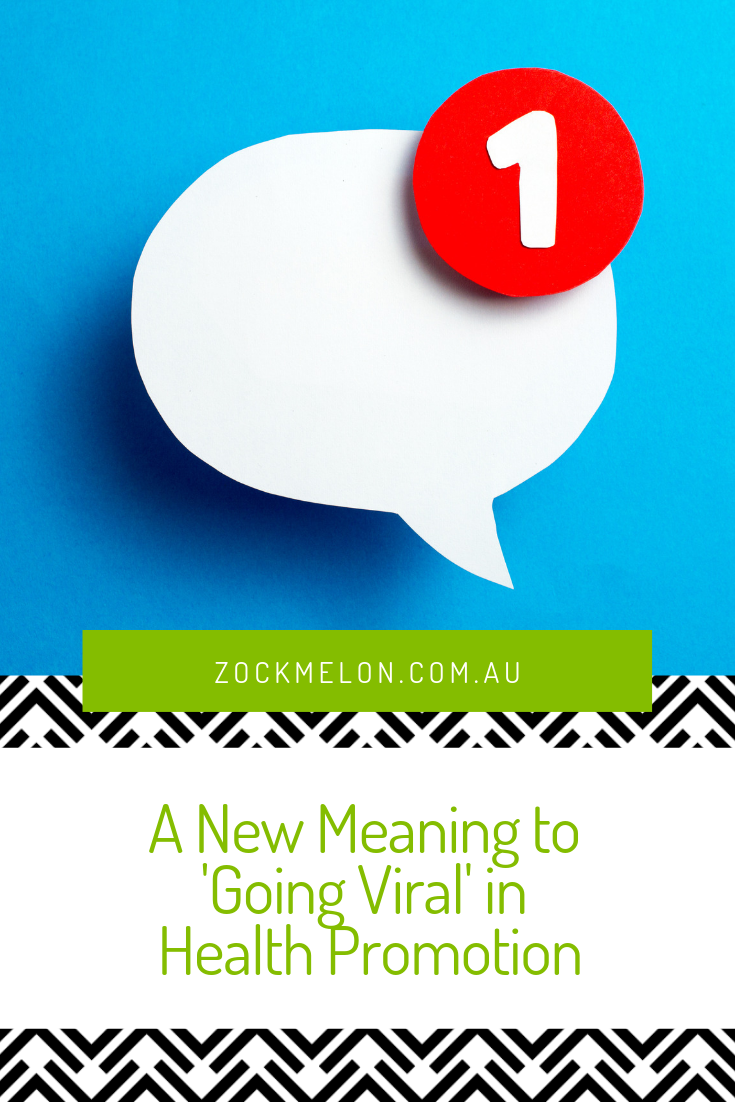At one of my first speaking engagements on social media and health promotion I was asked this question:
So, how can we make something go viral?
Even the concept of making something go viral makes me chuckle when thinking about social media and health promotion as previously working in the blood borne virus field we were trying so hard to not make viruses, er, go viral. Geeky virus joke. Sorry.
Back to the question: “How can we make something go viral?”
This person worked in local community setting, that is, in. a particular geographical area. She was organising a local event at the time. Why did she want it to go viral? So a plane load of people from another city would front up at the event? No, she didn’t really want her campaign and event to go viral. She just wanted lots of local people to attend, and for it to be a really good community event that was enjoyed by all. The end.
Think about your objectives – what are you really hoping to achieve by your campaign?
Some campaigns are created with the specific intention for them to be shared, and possibly go viral. Here is one such example from SA Health on their recent cervix screening campaign, which plays on the some e-cards meme which is very popular amongst their target demographic.
- Lots of comments, likes and shares which demonstrate a good level of engagement.
Names and profile images have been removed.
From this screenshot you can see that there was a high level of engagement with the campaign, with the numbers of shares, likes and comments exceeding what other posts on the SA Health page generate.
The closest thing to something ‘going viral’ of relevance to my audience member occurred recently when again a local community event for children and families was arranged and promoted on the host organisation’s Facebook page.
However, the host organisation did not set up a public event on Facebook, rather they just shared a picture of their flyer on their wall.
A member of the public, a mum with a big group of mummy friends, took it upon herself to set up a public event. She actually took the time to Google a relevant photo relating to the event and give the event a cover image. Before she knew it, she became aware that friends of friends and people she didn’t know were now going to “her” event. Wow! What a great result. Funnily enough the organisers had no idea that this had happened and they thought the good attendance was all a result of their flyers.
Note to all organisers of public events: Create a Facebook event to allow for easy ‘viral’ sharing and promotion!
Depending on who you ask, ‘going viral’ is either art, science or sheer, dumb luck.
While there is definitely an element of luck, there are things you can do to help it along.
Here’s our tips:
- Ask yourself – why do you want this to go viral? Is ‘going viral’ consistent with your objectives? If it’s really not, then relax!
- Give people something to share – something that makes them look clever, funny or helpful if they do share such as a great idea or tip. A bit of humour can go a long way.
- Give yourself a fighting chance of having something ‘go viral’ by creating an open, public event on Facebook so people can invite others, or get the ball rolling by sharing on your own page not just your organisation’s page, or paying for a promoted post, and cross-promote on all your platforms. Do you share other people’s content? Maybe to have your content shared you need to be a share-r and not expect to be a share-e.
- Use photos and “visual marketing”. With attention spans getting shorter and shorter (I applaud you if you have gotten this far into this article), use images rather than words to convey your message. Do you use a lot of stats or have access to stats? Now’s the time to create that infographic you’ve always wanted to do.
- Use #hashtags both in Facebook and Twitter and whatever other social media platform starts using hashtags in the future. This makes your statements and posts searchable and not quite so random.
- Remember that sometimes negative press gets shared as well as the positive. Strong emotions that evoke the need to share, and these emotions can be positive or negative, and people will share to get their opinions across or to see what their social network thinks. So much of the work in public health is vexed or has divided opinions in the community (think: anything parenting related, working with Indigenous communities, migrant health, STIs, schools…I could go on). Be prepared that the values and policy positions of your organisation may be shared with intent to shine either a positive or negative lens.
There are other strategies too, so if you would like to know more please make contact with us at Zockmelon so we can work with you.
For more information or some follow up reading, I recommend Jonah’ Berger’s article and book ‘Contagious’.


